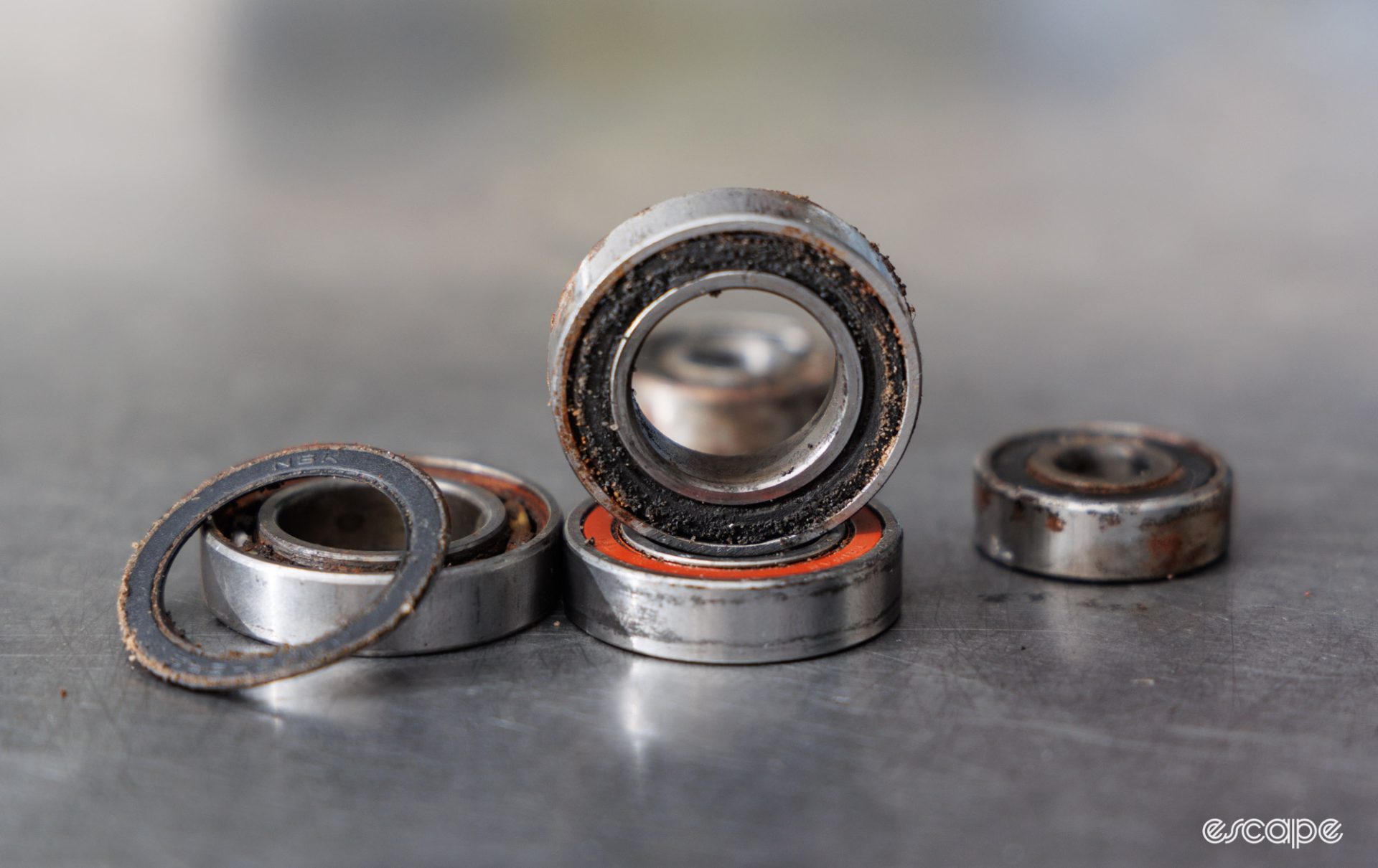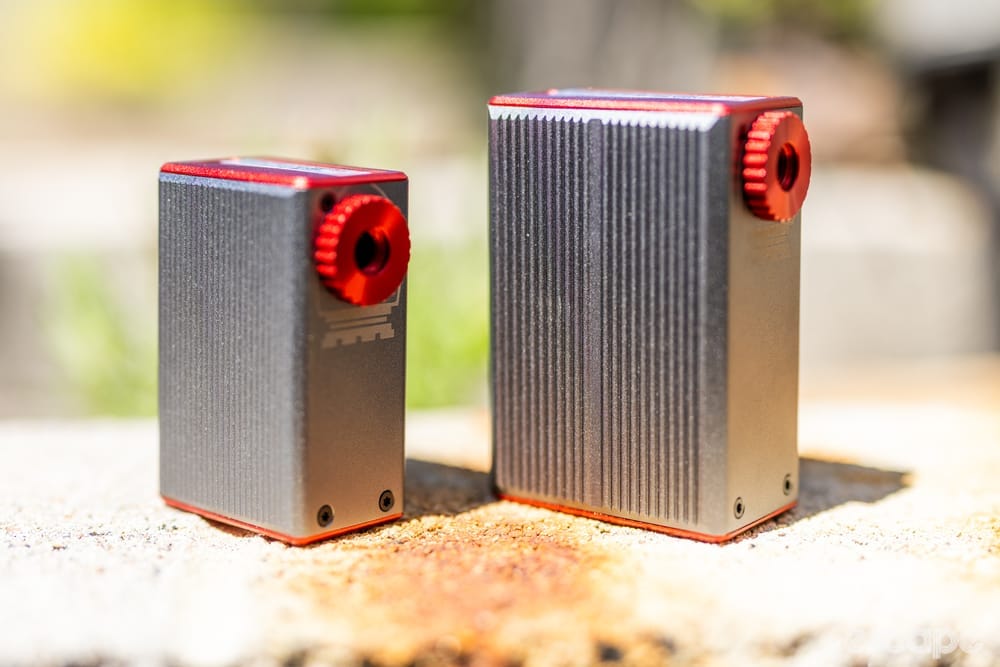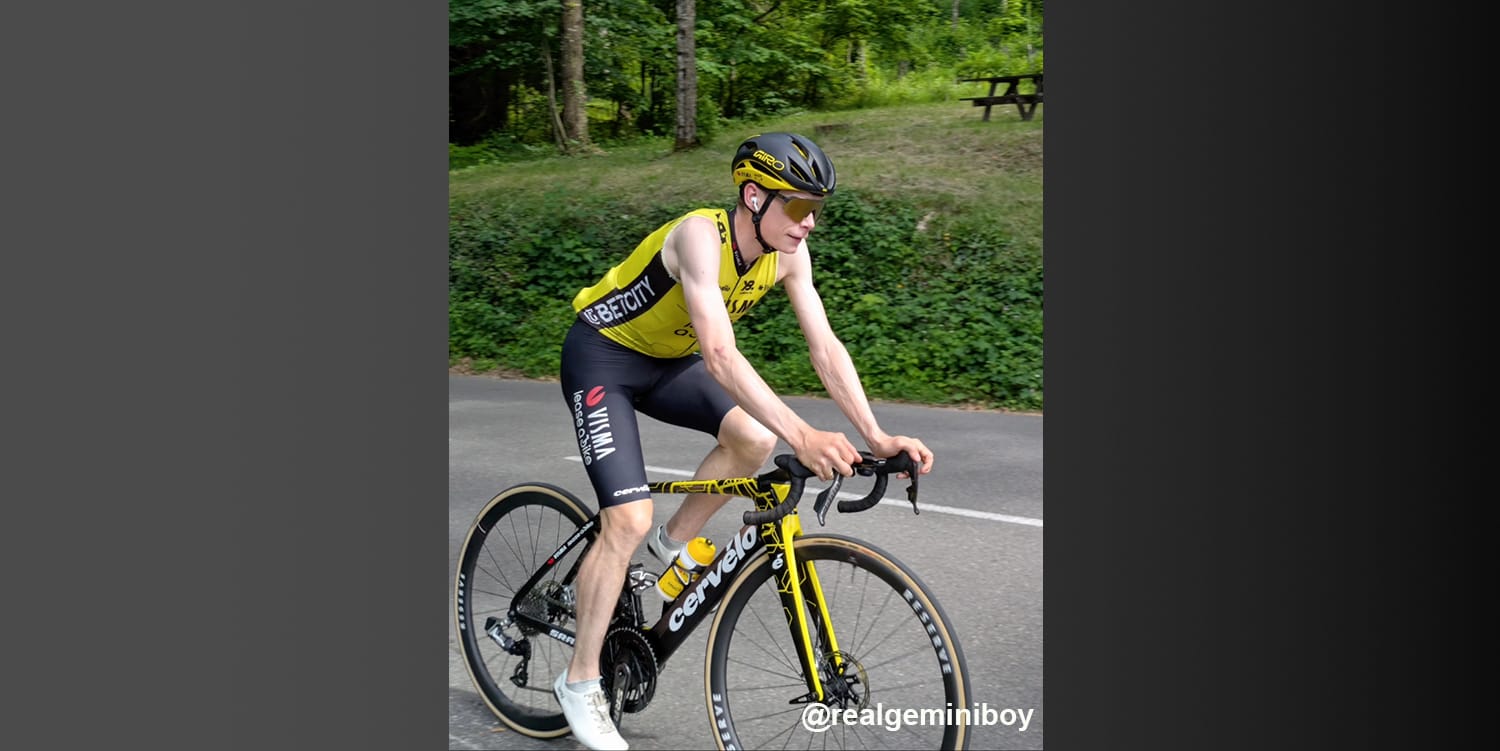The fact that I have a whole tool cabinet drawer (and then some) dedicated to specialist tools for removing small cartridge bearings (aka, sealed bearings or deep-groove ball bearings) tells that I think about the task of bearing replacement more than I should.
At the root of my fascination with this topic is the simple fact that many major brands in the industry have continuously proven that bearing installation is considered (and is often relatively easy), but rarely is such consideration given to the eventual removal of those same bearings once worn (especially concerning rear suspension pivot bearings). The result is an expensive category of tools with no silver bullet solution; often, problem-solving is the best tool of all. Without a doubt, this confusion is the reason why I’m asked about this topic of tools more than any other.
In this edition of Threaded, I’ll take you for a stroll through my mind of cartridge-bearing removal, including common problems, why I try to avoid using simple pin punches, and what my preferred bearing removal tools are. Indeed, this is an almost never-ending category of great expense (even for professionals with access to trade prices), so please consider this a story of general interest and professional insight rather than an exhaustive DIYer guide.
I’ve limited my focus here to common bearing removal situations and the methods I’ve found best to overcome them. However, almost every bike or bearing-equipped component will have nuance in servicing, so there are countless scenarios where the advice, techniques, and required tools will vary. Always consult with the manufacturer if you're unsure, and in many cases, this may be one of those occasional repairs best left to a professional. This is part one of what’s sure to be a multi-part series in working with cartridge bearings. In future, I’ll cover how to measure for replacement bearings and of course, installation.
Keeping it square
Cartridge bearings have become ubiquitous on modern bicycles. Made to be a self-contained and replaceable bearing unit, cartridge bearings consist of an inner race, an outer race, the ball bearings, and in most cases, there’s also a retainer for the ball bearings and protective seals. While some component and frame designs do a good job of protecting these bearings from the elements and unwanted load demands, others will encourage premature failure, which will require replacement.
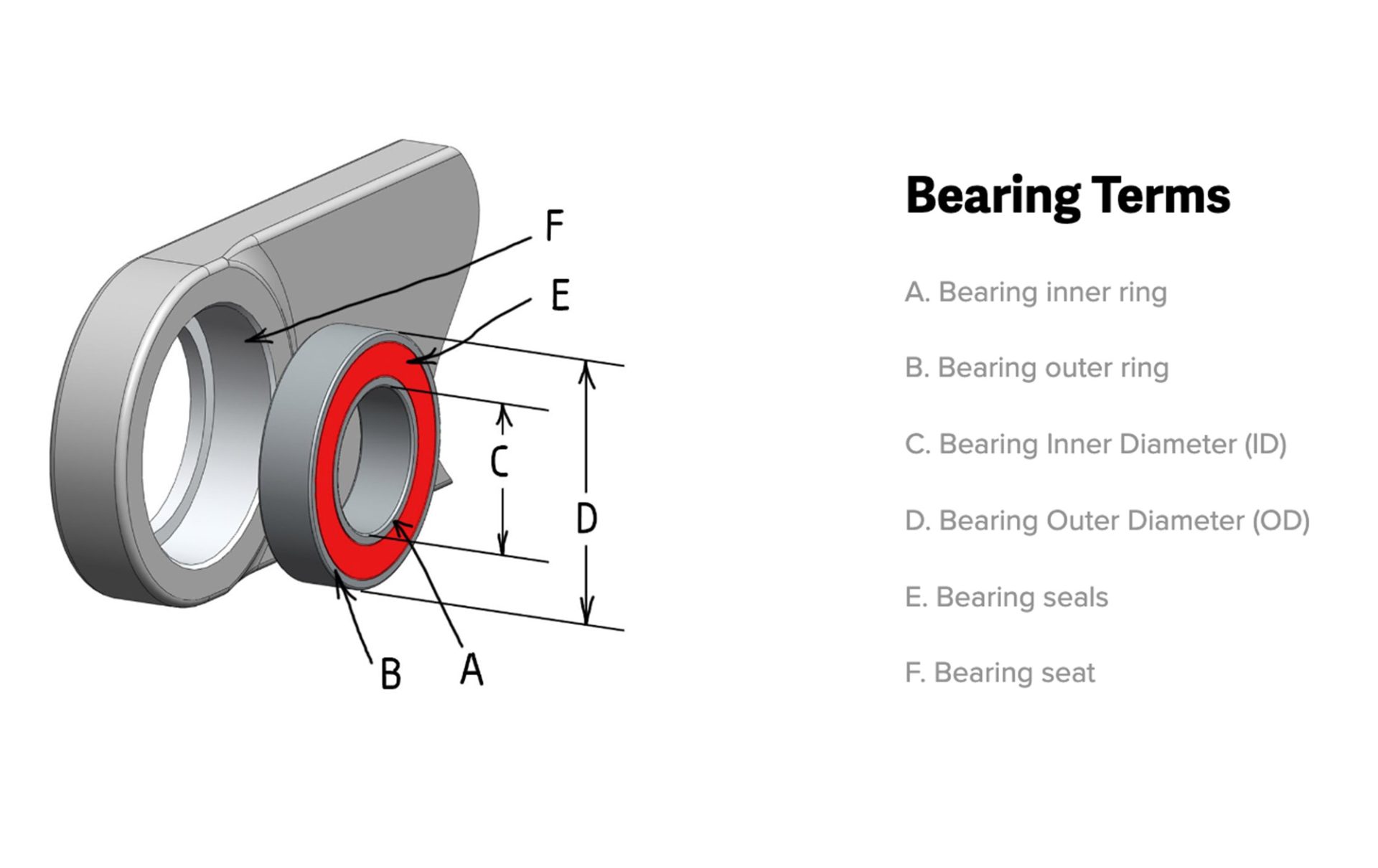
Things quickly get complicated in the sheer number of bearing sizes used across a bicycle, many of which are non-standardised. It’s common for a single rear hub to have two or even three different bearing sizes within it, a rear suspension linkage may use a different bearing size at every single pivot location, and of course, bottom brackets and headsets are no more standardised. Adding to that stress are the many ways bearings are used, and that some that are installed without considered design for replacement.
In most bicycle applications, the outer race creates the press-fit that keeps the cartridge bearing in place. The correct installation process is to press on the part of the bearing that is responsible for the press fit. However, this then means you’re often blocked from removing the bearing in the same way. Instead, you often only have access to pushing or pulling on the inner race for removal.
The common and most cost-effective approach to bearing removal is to use a hammer and a long parallel pin punch against the inner race to knock the bearing out. The correct technique requires patience as you tap on one area, move the punch to another part of the race approximately 90° away, tap, and repeat as you walk the bearing out of its retaining surface as square (perpendicular) as possible.
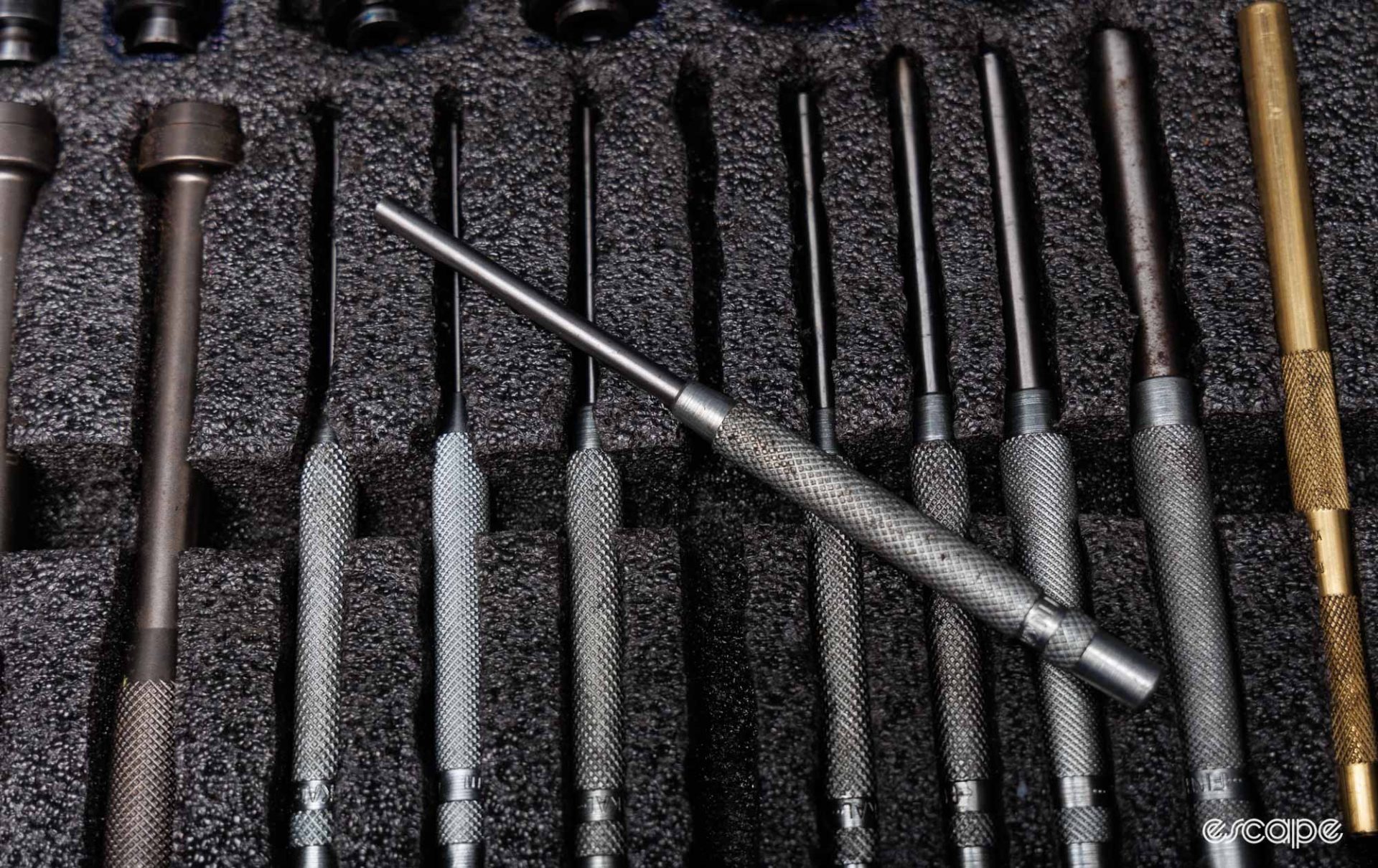
This presents two issues. Firstly, a punch forces only a small area of the bearing to move, and walking a bearing out unevenly can cause damage to the precise (and often soft aluminium) bearing seat. Secondly, by hitting only a segment of the inner race, you risk dislodging it from the bearing assembly, leaving the bigger problem of extracting just the remaining outer race that is often concealed by whatever it is pressed against. The more worn and/or corroded a bearing is, the more likely this second issue becomes.
Pin punches can work with good technique, sometimes they are unavoidable, and they’re a handy workshop item for various other tasks. When shopping for pin punches you want something with a few different diameters, long lengths for access into rear hubs, and with non-chamfered edges at the face.
That said, my preferred approach is to use specialist tools that push, knock, or pull the bearing out square. Keeping the bearing square is best for the bearing seat, it’s less likely to explode the bearing, and it requires less effort, too.
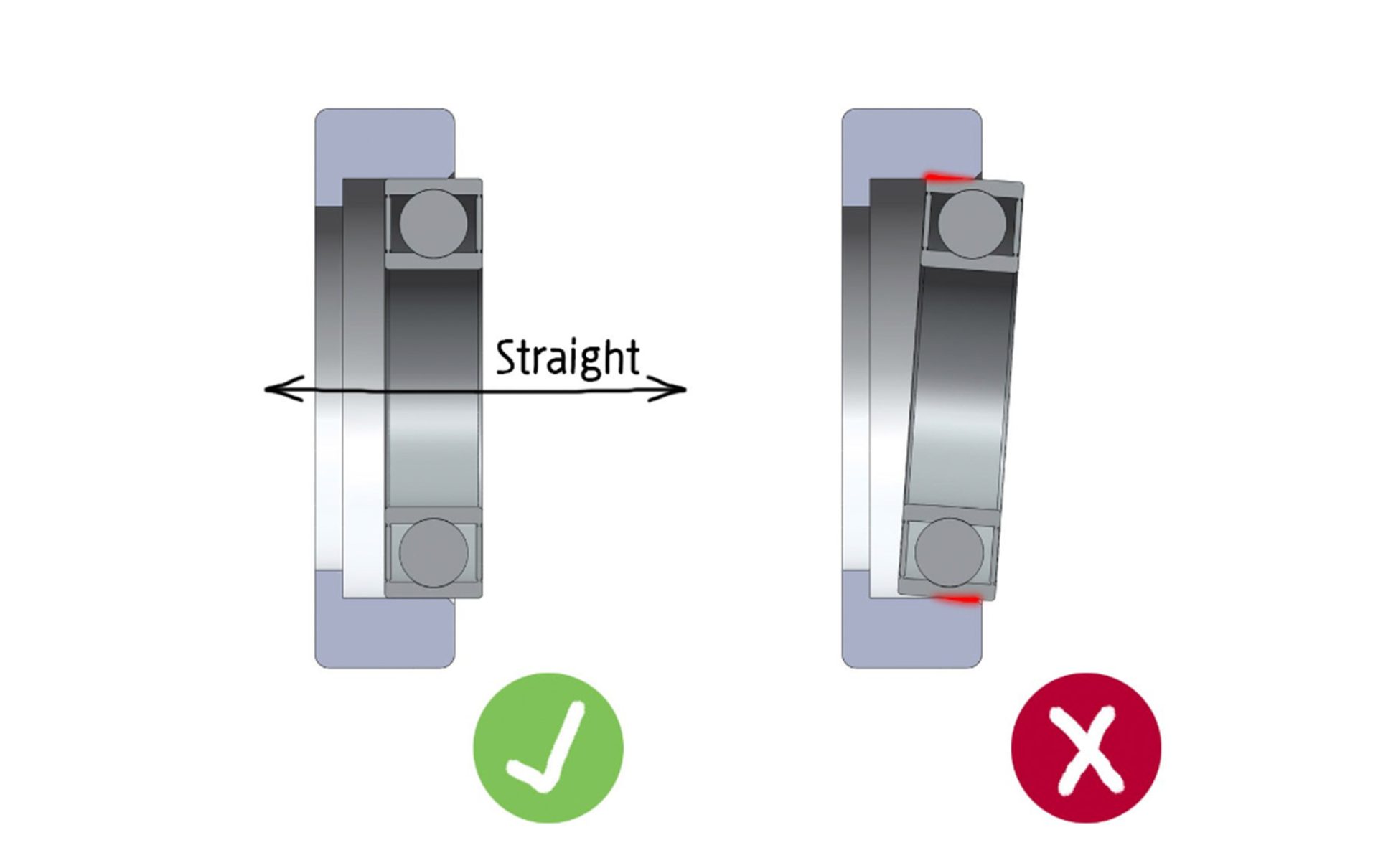
Pullers versus Hammers
Just a few years ago, it was standard practice to use a hammer whenever removing any bicycle bearing, and while that remains true for many, there are now a number of specialist tools that aim to do the job without brutality or risk of a missed strike. I still use hammers today, but if I can’t correctly (and safely) brace the corresponding component, I prefer even fancier bearing removal tools that often call for a bearing press or similar threaded rod.
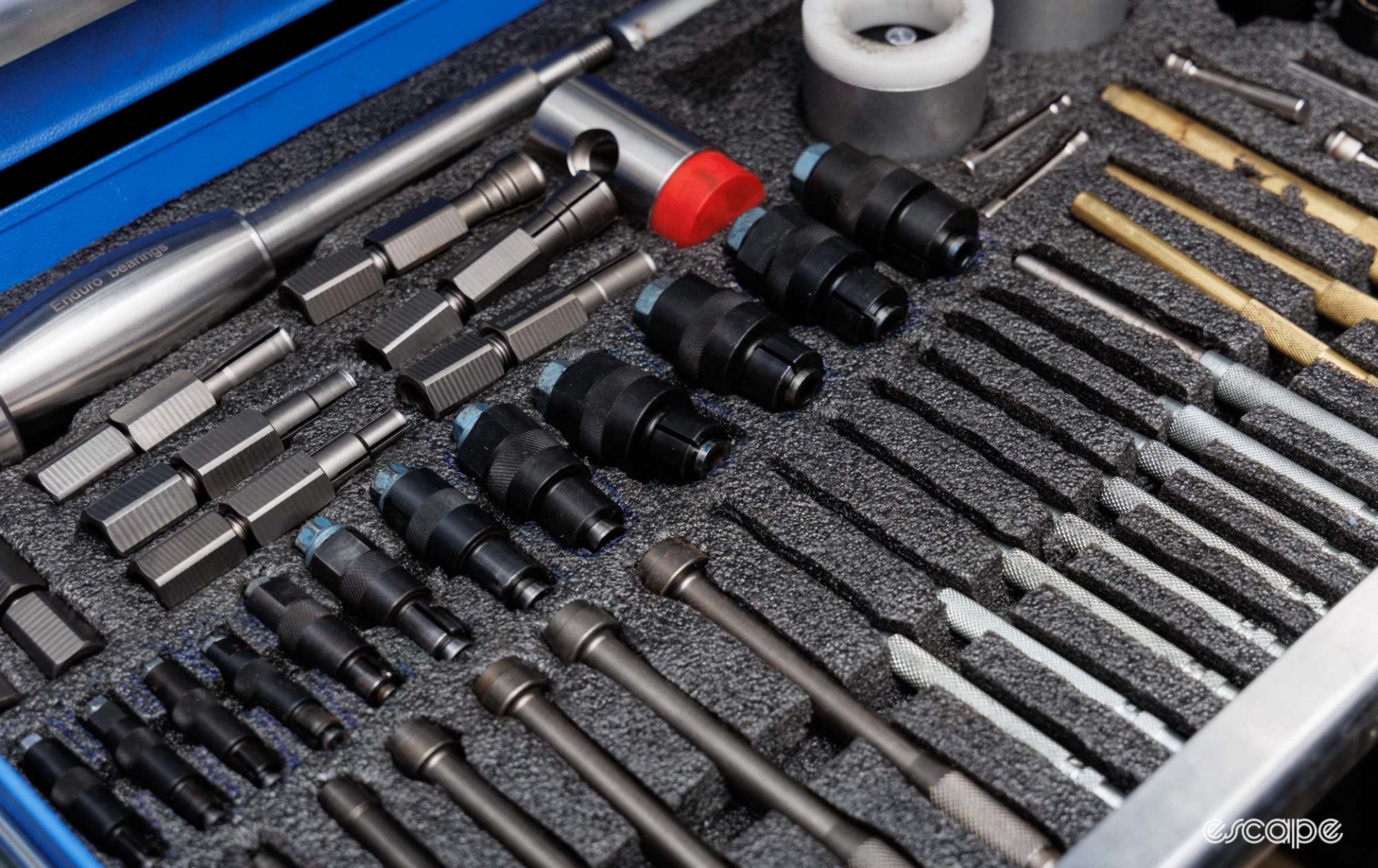
Hammers can be in the form of your household claw hammer, a mallet, or something similar that requires you to swing them (a topic that deserves its own article). Hammers are an effective means for creating a force, but when it comes to removing bearings, a common barrier is supporting the holding piece so that forces aren’t transferred elsewhere. As a related point, there are also slide hammers that thread onto special collets and effectively let you pull on something with a hammering action. however, I've found these to be less effective at creating efficient force and can be more cumbersome to use, too.
By contrast, the hammer-less bearing tools typically work on the common theme of having a receiver cup that is sized larger than the bearing being removed and which works as a lever. There is typically a plate, expanding collet, or similar that attaches to the inner race of the bearing; a threaded tool is then used to pull the collet/plate and receiver cup together – in the process removing the contained cartridge bearing that sits between. This tool style can be a dream to use, but there are caveats.
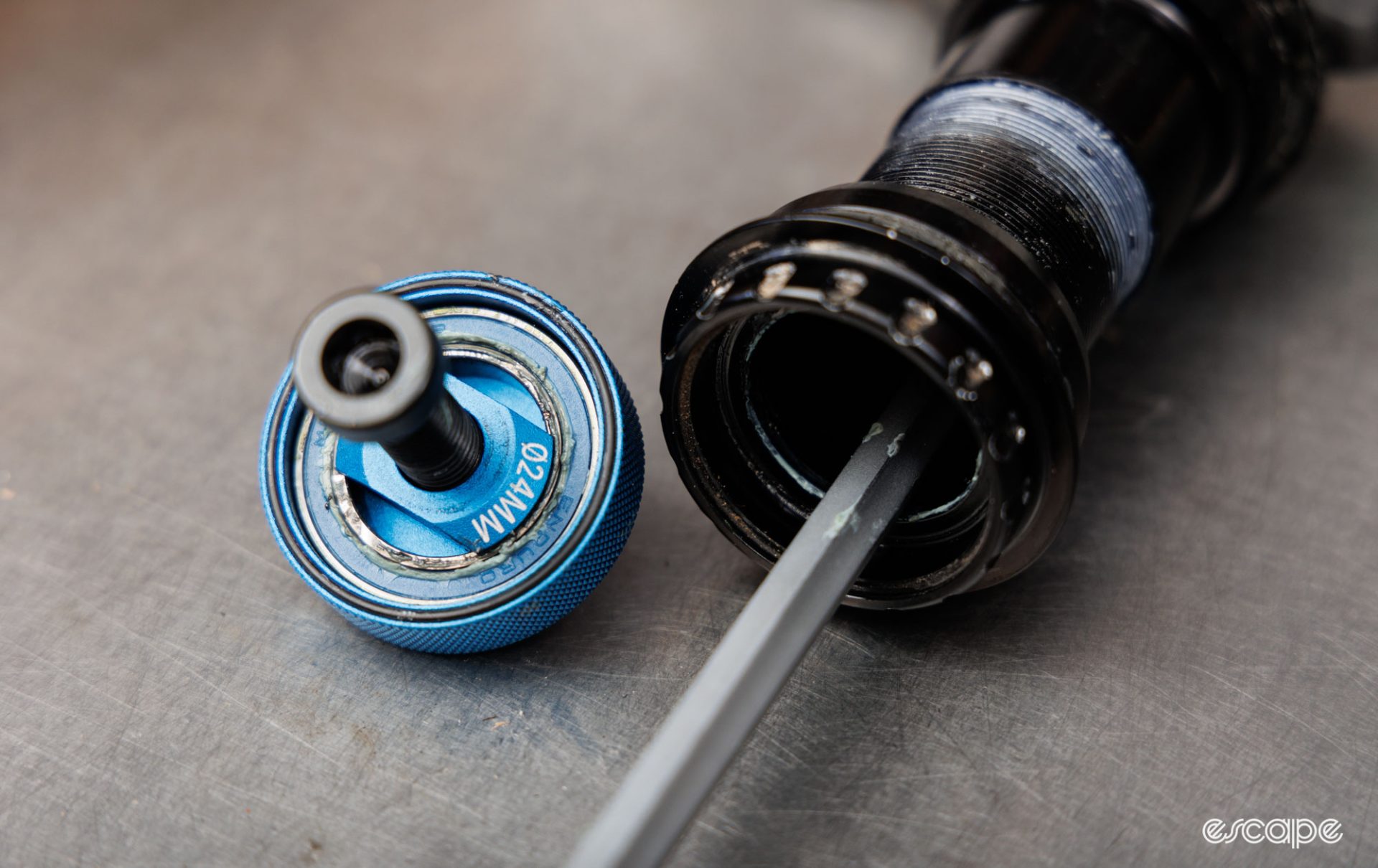
Firstly, these bearing pullers need a flat surface around the outside of the bearing to leverage against. Sometimes, there won’t be adequate material thickness around the bearing; other times, the surface isn’t flat and, therefore, would force the tool out of alignment to the bearing (a common problem found with some rear suspension pivots). In these circumstances, you’re often back to using a hammer-based tool for removal.
These puller-type tools also need a way to attach to the bearing, and sometimes internal preload spacers or poor clearance can prevent that. I’ll repeat this a few times, but there is no silver-bullet tool for all bearing removal situations.
Five types of cartridge bearing removal scenarios
Contained axle
Commonly found on rear hubs (such as DT Swiss), a contained axle (or over-axle bearing configuration) refers to a design that uses a shouldered axle that is sandwiched between a pair of cartridge bearings. In this scenario, hitting one side of the axle with a non-marring hammer would drift out the bearing at the opposite end. You’d then put the axle back in to drift out the second bearing (assuming it’s not blocked by a snap-ring, lockring or drive ring!).
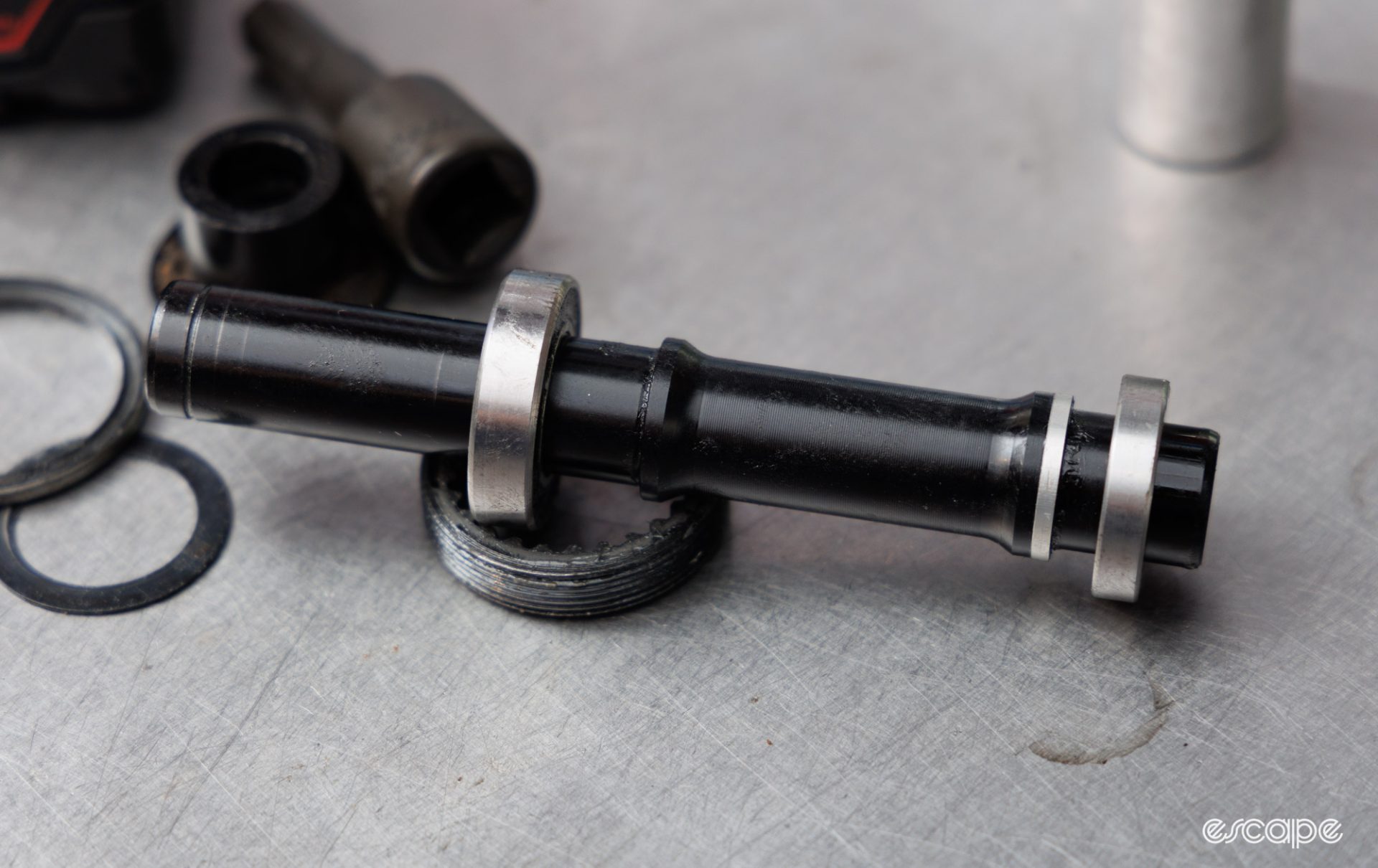
This style of bearing configuration is the easiest to remove, although care must be taken to ensure you don’t damage the often thin and soft aluminium axle ends. Here, my method includes protecting the axle end with a small tool, such as that provided in DT Swiss’ hub service kits or an aftermarket version sold by BSC Tools (UK-based). Alternatively, if you have a 3D printer, you can print one.
I like to elevate and support the hub/wheel by laying it on a non-marring hub holder – my preference is a handy tool Hope offers at a fair price (#HTT167). Alternatively, you can achieve much the same by cutting a hole through a small bit of ply wood, or again, you could print one.
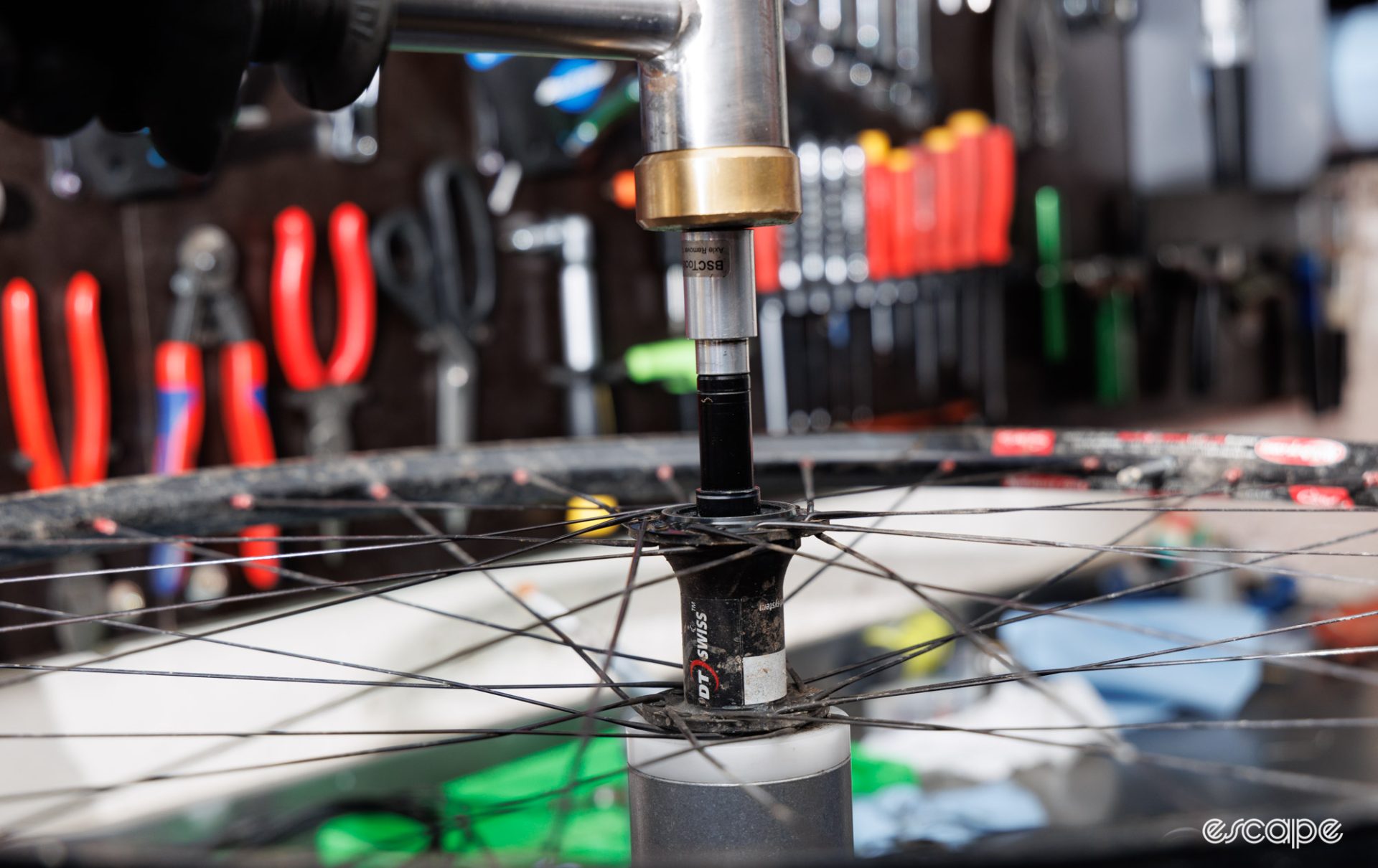
If you’re trying not to wake the baby/dog/neighbour, you can get fancy and press the axle out. CeramicSpeed’s desirable Wheel Press tool kit was one of the first tools I saw to offer this feature. Since then, Canadian-based Alt-Alt (see previous coverage of the Alt-Alt kit here) has brought a similar feature to a substantially lower price point. And of course, the faithful 3D printer plus your threaded press of choice can create similar. I have these press-based options, but I typically reach for the hammer, hub holder, and axle-protector because they’re faster and provide more tactile feedback.
Open access
Open access is where you have unhindered access to removing a bearing from behind – a scenario that is commonly introduced after you remove the first bearing in a hub or rear suspension pivot. I’ll come back to how to remove that trickier first bearing, but for now, let’s assume you have open access to the backside of the bearing.
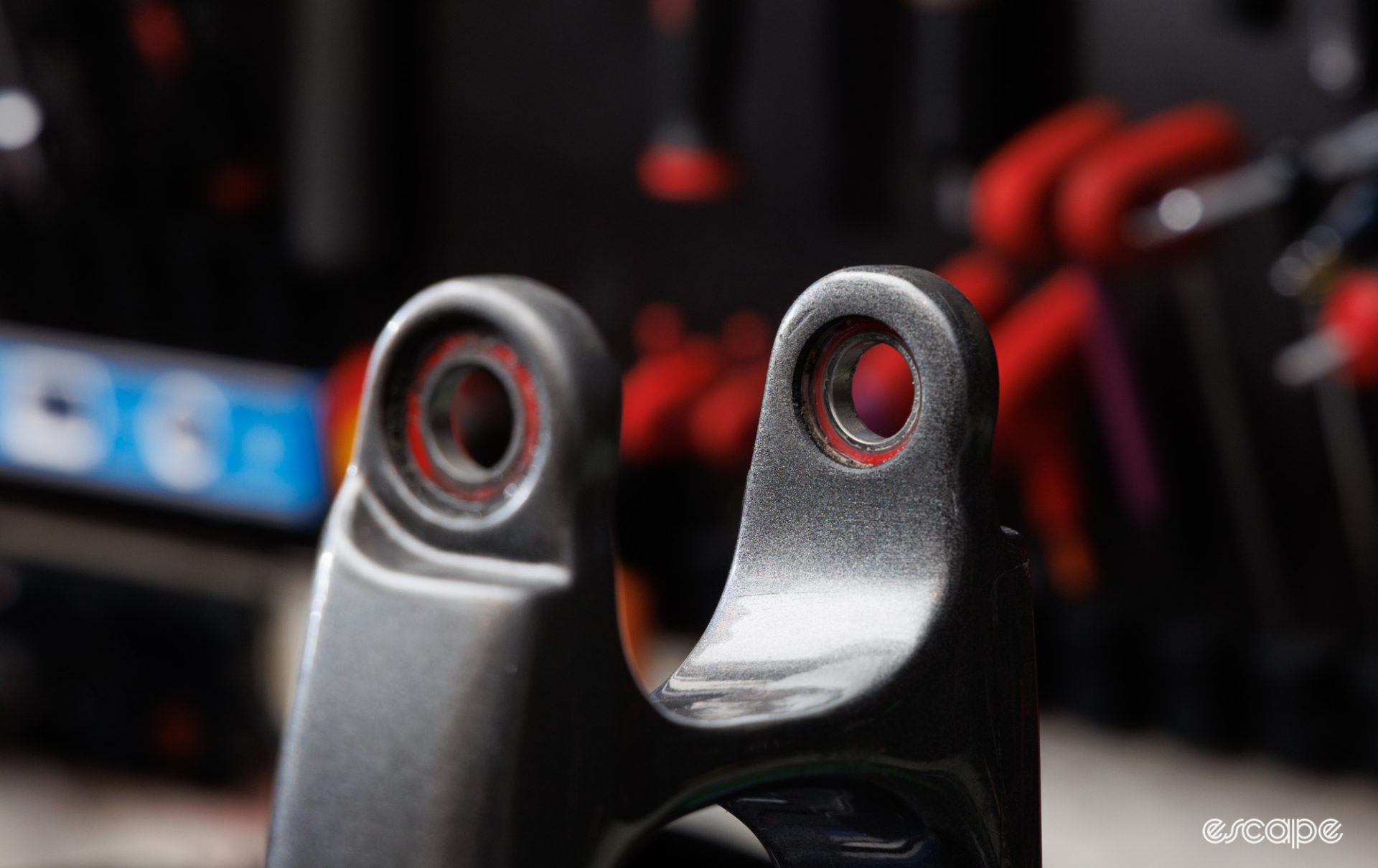
As one of the simpler scenarios, any form of bearing removal tool or technique can work (including those covered in the next sections). For hubs, I like a tool from French tool maker VAR that uses simple slotted metal collets that expand into place behind the bearing when the supplied punch is inserted. It’s quick to use, can be used with semi-blind bearings, and it’s effective at keeping the bearing race square.
With true open access, I also appreciate the focused purpose of Enduro’s BRT-030 stainless steel bearing punches that are sized to sit into the centre of inner races and allow quick and square removal. However they are expensive for a tool that works solely for this scenario.
Meanwhile, for rear suspension frame pivots with open access to behind the bearing, my go-to is the cute Enduro BRT-051 set. This features dual-sided inner press adapters and outer receiver cups that span many common sizes of bearing. You then combine these with a compact bearing press (8 mm rod or smaller), which squeezes the two pieces together, pressing the bearing out in a way that’s so easy it feels like cheating. Compared to other options on the market, Enduro’s impressively compact version is brilliant because there are small cut-away windows on the receiver cups to clear common uneven external surfaces present on many full-suspension frames. Recently Enduro updated its modular press kit (BRT-060) to include the impressively useful BRT-051.
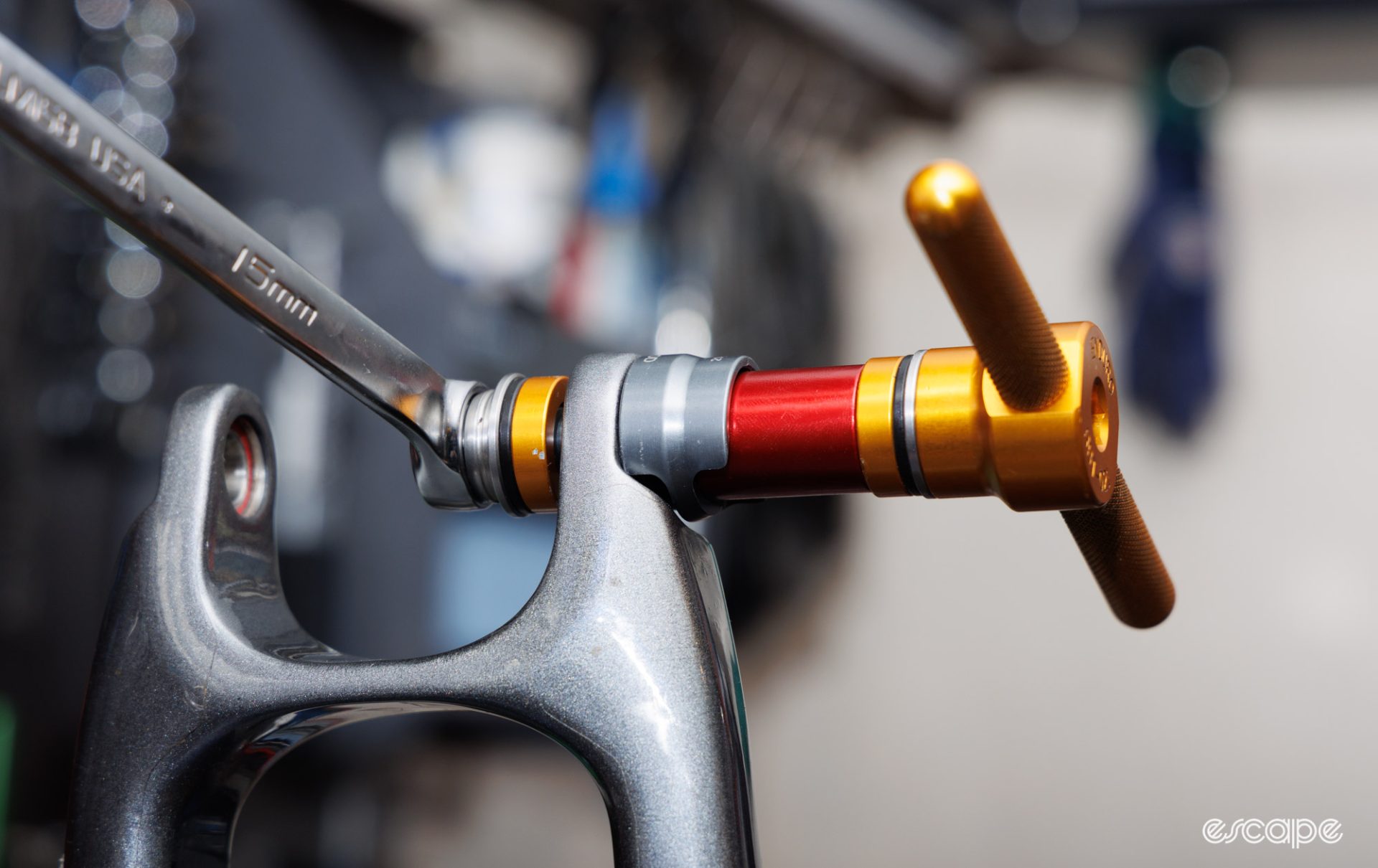
Another option that features cut-outs for uneven surfaces is from Real World Cycling (RWC), or once more, you could 3D print something of a similar concept. Alternatively, if the surface you’re pulling against is flat and square (perpendicular) to the bearing, then other puller-based kits do exist from the likes of Alt-Alt (a great value and well-considered option), Rapid Racer Products (RRP), Session USA, CeramicSpeed, and the list goes on. Or you could go old-school and use a socket set with a G-clamp or bench vice – here you squeeze a small socket behind the bearing against a socket larger than the bearing.
Semi-blind
Semi-blind is the most common scenario in bearing removals, where a second bearing on the opposing side of the component/frame blocks access to the bearing being removed. This scenario is commonly found with press-fit bottom brackets, headsets, hubs, and of course, those pesky rear suspension frame pivots.
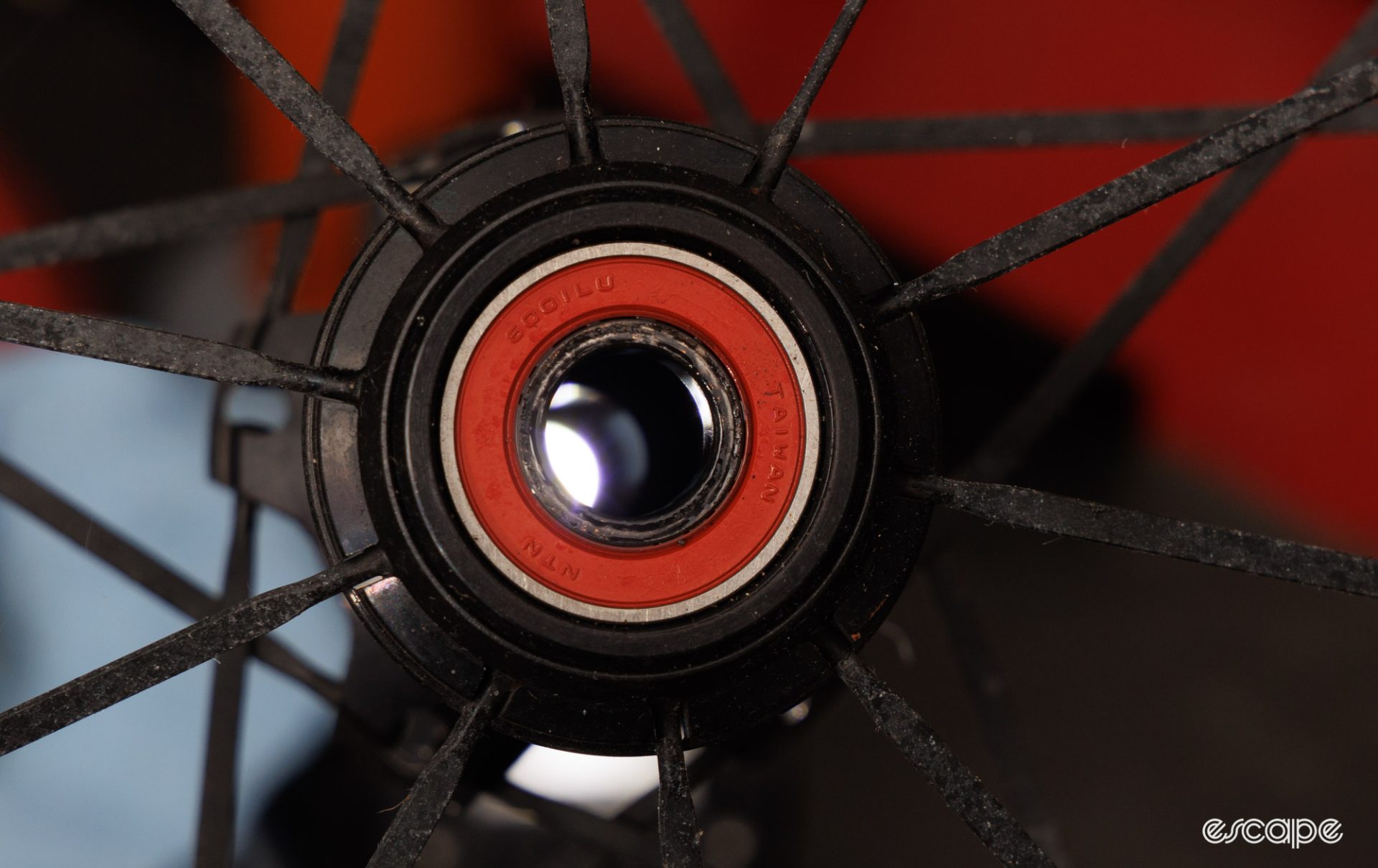
The general approach to dealing with semi-blind bearings is to use a pin punch and a zen-like balance between care and frustration, but as already explained, I try to avoid that. Rather, this is the domain of specialist tools designed specifically to remove the bearing as smoothly and straight as it was first installed.
The previously mentioned VAR Hub Bearing Extractor Kit (source from UK/EU) is a great option for hubs and some rear suspension pivots. The expanding collets make quick work of semi-blind bearings, and then quickly remove the second bearing, too. However, these will be defeated if a spacer tube exists behind the bearing or if the bearing seat has a pronounced back wall.
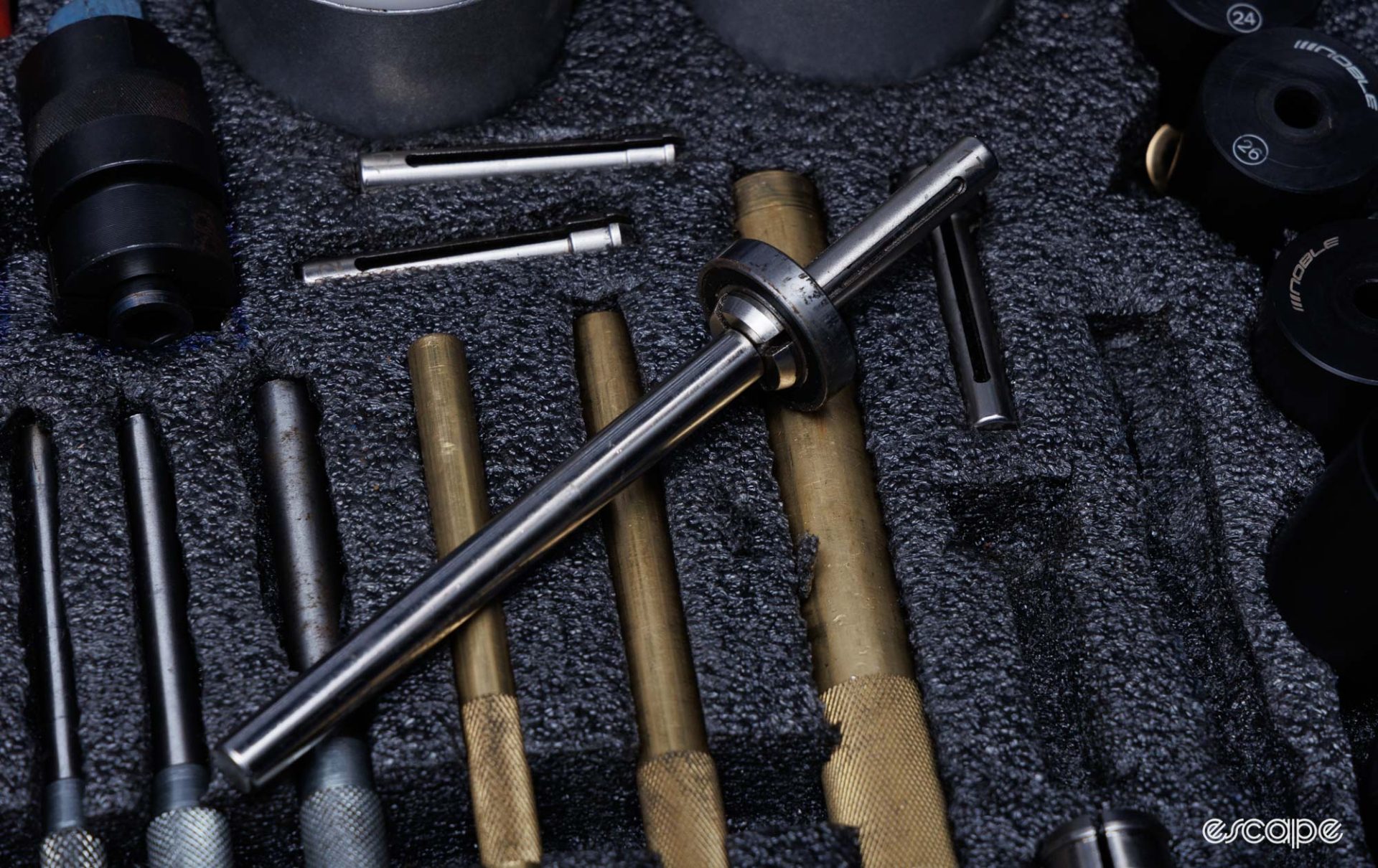

There are more sophisticated hammer-based expanding collet options, too. The most common would be those included in a blind hole-bearing removal kit (see blind access below), although, as mentioned, I’m not a fan of the ineffective force generated by a slide hammer. Instead, a preferred option is a bearing expander that blocks off the centre hole of the bearing so that you can squarely remove the bearing with a pin punch and hammer. Wheels Manufacturing is the brand I use here, and their tool features a guided hole for the pin punch to rest within. However, a cheaper (albeit less-polished) alternative is from UK-based Bearing Pro Tools.
Then we come to the clever puller-based tools for semi-blind bearings. Once more, the biggest restriction to these tools is having sufficient, flat, and perpendicular material around the bearing to pull against – if you don’t have this, then you’re likely back to using a hammer.
Here, Alt-Alt’s Alt Drift eccentric design slips into the bearing and then drops a few millimetres off-centre behind the inner race. It’s a clever design, so clever you’ll probably need to watch an explainer video to understand it. And I’ll also mention the dreamy Noble Wheels pullers which changed the game and then quickly became collector’s items with the recent closure of the company (update: these are now back in production thanks to Abbey Bike Tools).
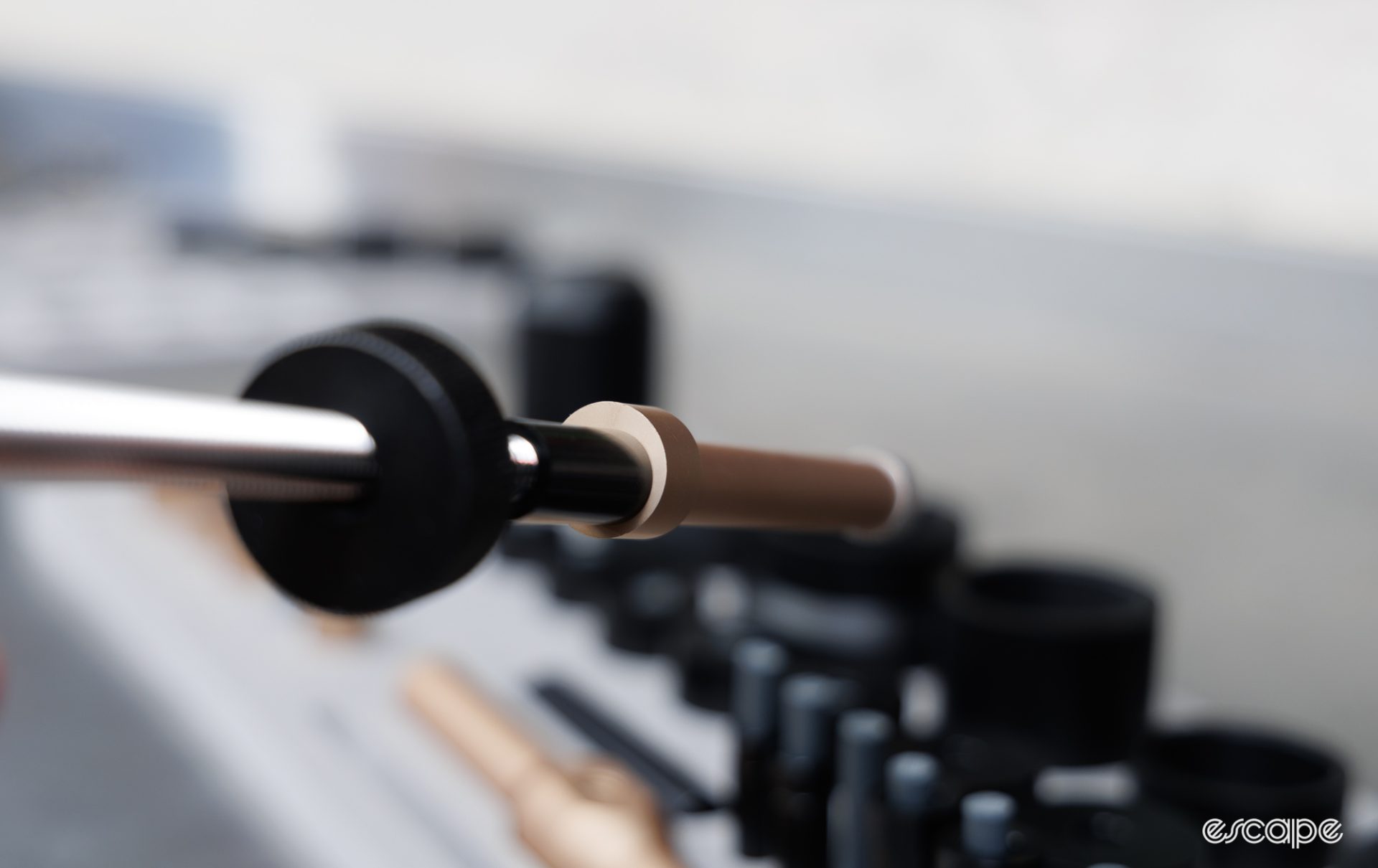
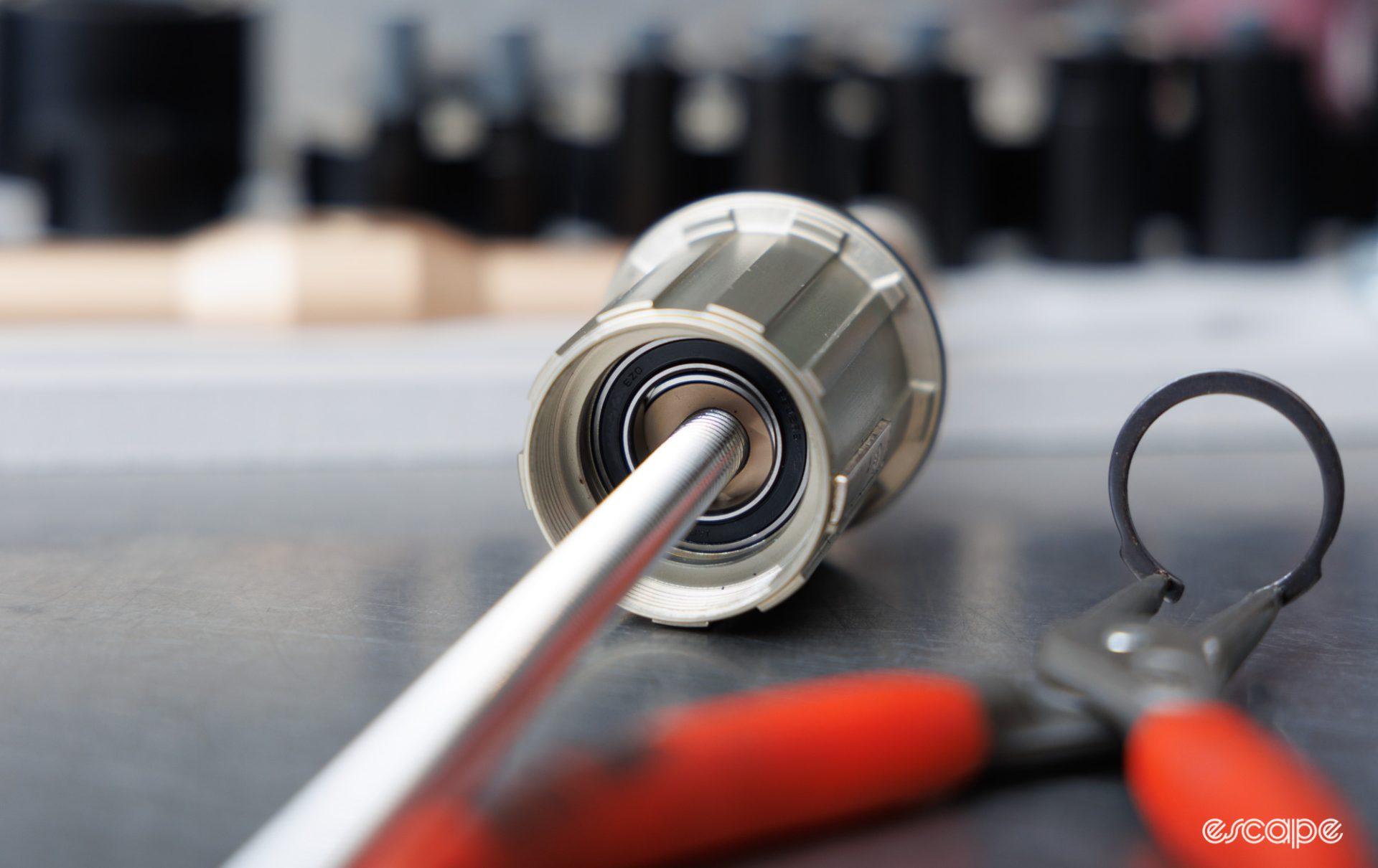
So far the tools suggested are for smaller bearings applicable to hub and rear suspension pivot service, but what about the larger bearings in your bottom bracket or perhaps rusted headset? While often presenting the same bearing removal problems, the larger size of these means they typically demand different tools and therefore deserve a dedicated article. Still, it’s worth noting that some of my favourite tools are the thread-based press-fit bottom bracket tools from Enduro Bearings. A distant second choice in this domain would be the bottom bracket puller from BSC Tools (it has more clearance limitations, slower set-up time, and more limited pulling power when compared to the Enduro tools, still it beats many hammer-based options).
Spacer tube restricted
Ah yes, the spacer tube, the source of much mechanic frustration. It’s a common feature designed to control the preload of bearings, to connect the turning of distanced bearings, to reinforce the inner races against angular forces, to ensure correct bearing placement when there is no bearing seat, and/or often, just to make grown adults with tools cry. You’ll often find spacer tubes hidden within freehub bodies, within seat tube pivots of full suspension frames, and in front hubs. And if a metal tube jammed between two bearings wasn’t frustrating enough, they’re often also made of surprisingly soft aluminium and with spares as hard to source as a left-handed screwdriver.
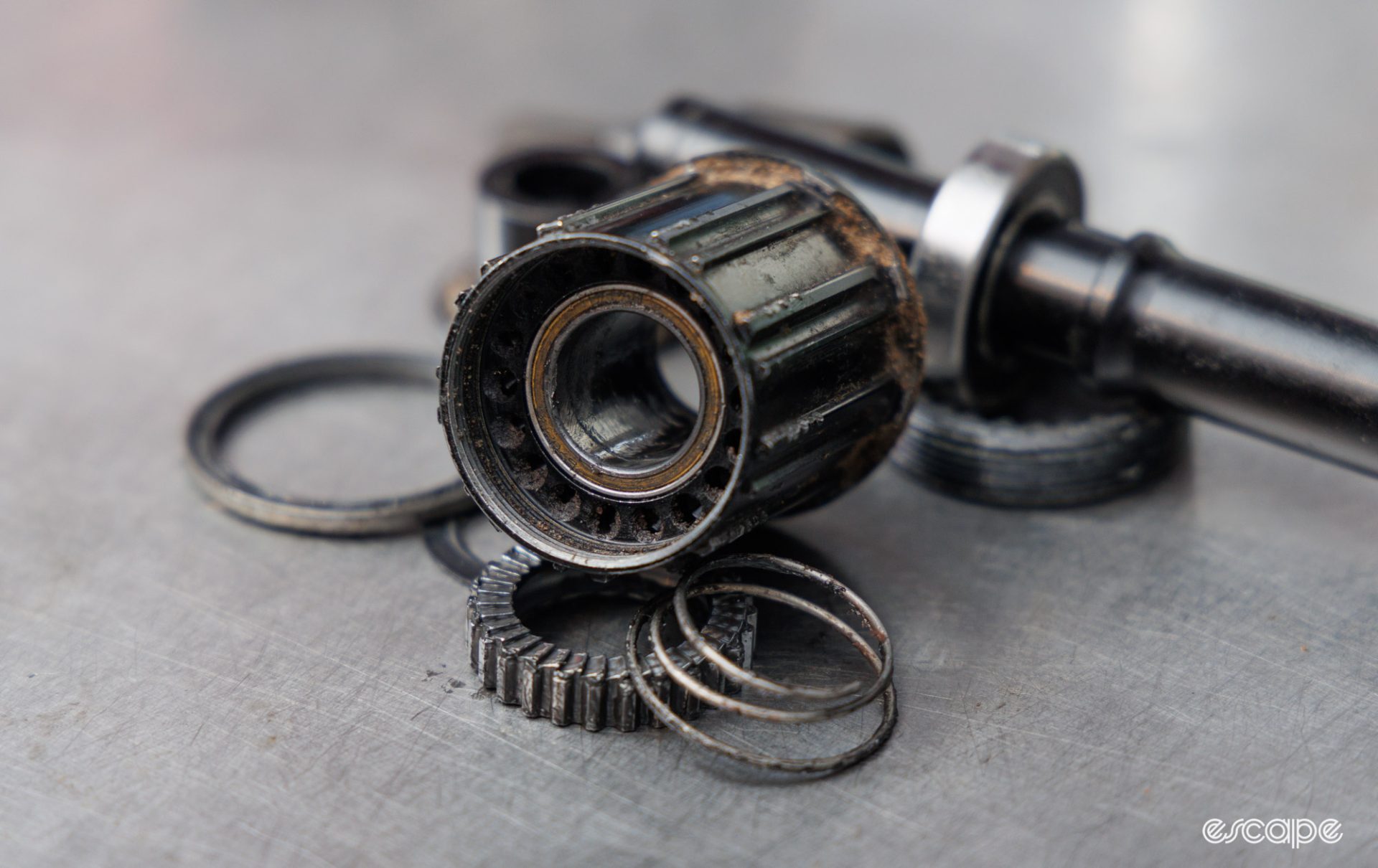
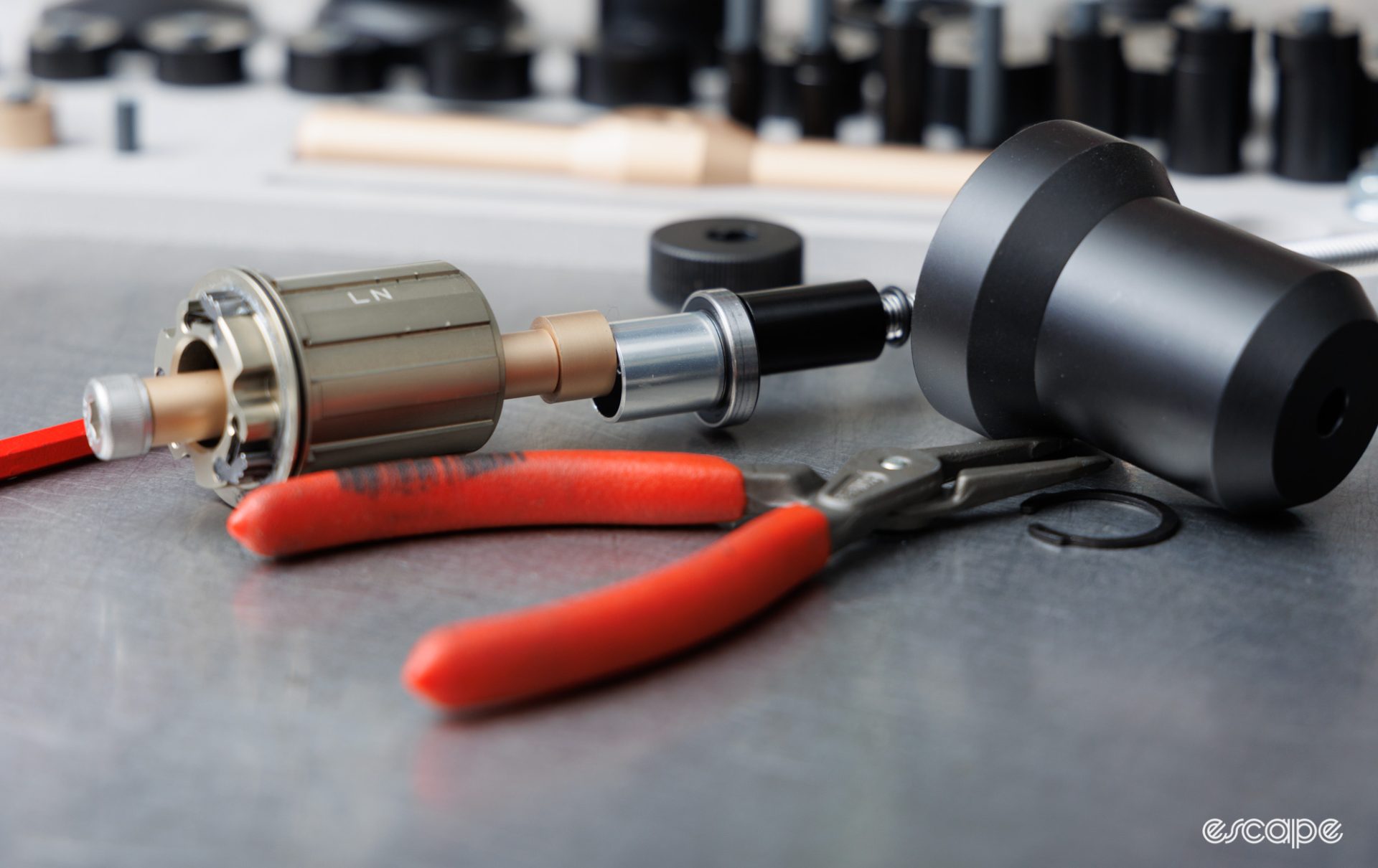
Once again, the common method for removing a bearing blocked by a spacer tube is to use a pin punch. And while I admit that sometimes this method is unavoidable, I still prefer methods that keep the bearing square (or as close to).
My former go-to was the expanding collets from Wheels Manufacturing, often combined with a means of supporting the component. These often get the job done, but occasionally the blunt design fails to grasp the bearing tight enough – especially if a tight spacer tube is present. Additionally, the expanding design makes tight bearings even tighter – not ideal. As covered above, you can also use the expanders from Bearing Pro Tools or a blind hole-bearing tool.
If using such an expanding-type tool, care is needed not to engage the collect jaws with the spacer tube behind the bearing. Some spacer tube and bearing combinations have a bevelled edge that allows safe extraction with this type of tool, while others don’t. Once more, the silver bullet is nowhere to be found.
Recently the Alt-Alt Alt Drift and Noble’s pullers came to market with the core goal of solving the spacer tube problem. The Alt-Alt design is genius, but will only work if the spacer tube can be shifted off-centre by at least 1 mm – which while common, isn’t always possible. Meanwhile, the Noble tool is a different kind of genius, but alas, no longer available (update: Abbey Bike Tools now makes it).

Even with all the tools, bearings blocked by spacer tubes can sometimes be the uninvited guest of modern bicycle service. Even with all the fancy tools, this is one bearing type that still has me reaching for the hammer and punch more than I want. Sigh.
Blind access
Blind access is when you have no access to push the bearing out from behind, and rather, you need to pull it out from the same direction it was first pushed in. This problem is occasionally encountered on some rear suspension frame pivots where a blind hole bearing remover (commonly used with a slide hammer) is the correct tool for the job. The task of blind bearing removal is also seen if a bearing has collapsed and you're left with just the outer-race to remove.
I do own a fancy Enduro bearings Blind Hole tool, which is lovely to use, grabs the bearing impressively well, has a more pronounced “snap” to locate itself between tight gaps, and has proven to be a more durable choice. However, its price is well out of reach for most casual users.
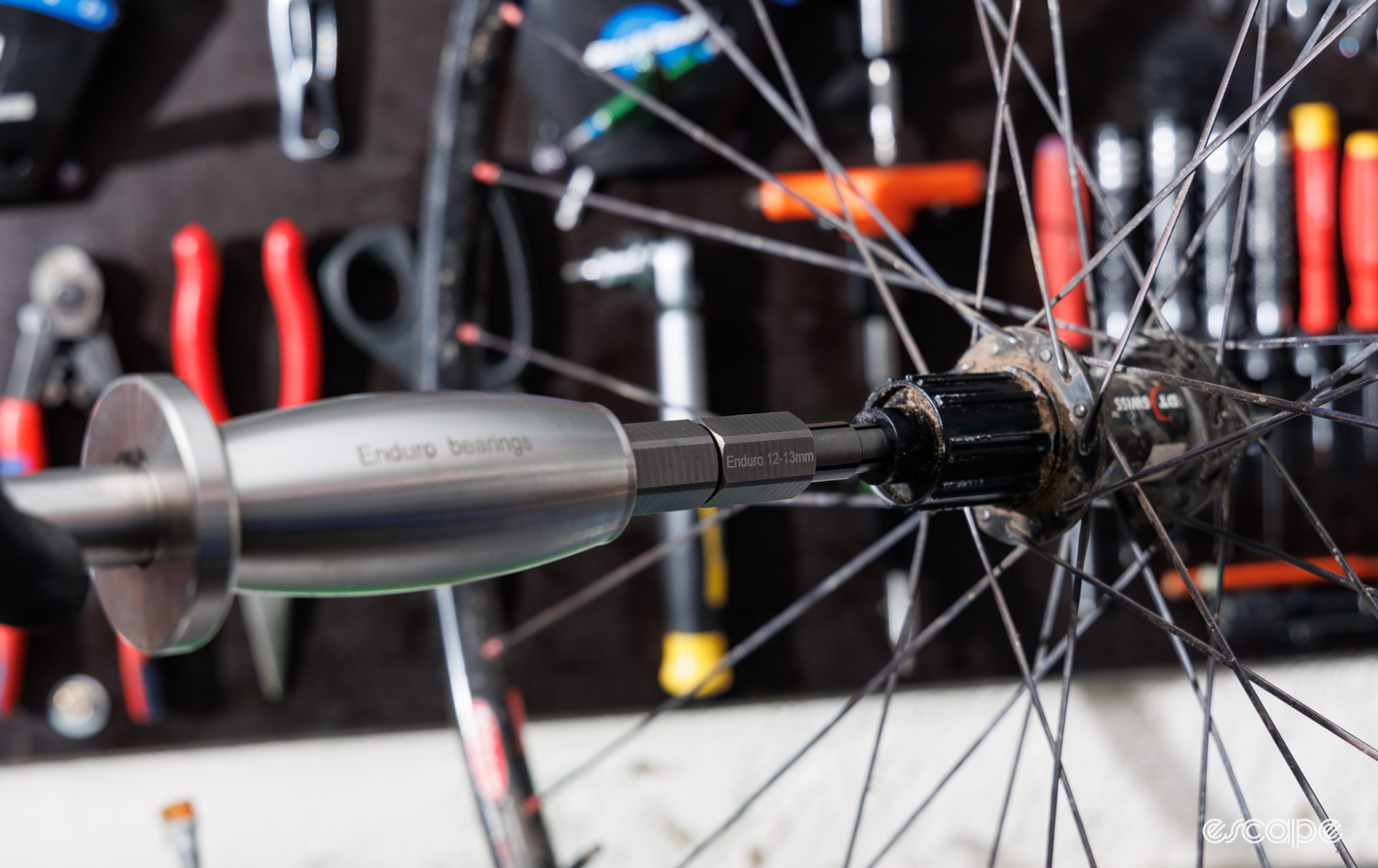
Rather, generic blind hole-bearing tools from Amazon, eBay, or even Aliexpress do the job surprisingly well for little money. I’ve owned a few, and my favourite is an 16-piece automotive kit that spans a size range from 8 to 58 mm, and includes both a puller and slide hammer – while not the very cheapest option, the longer collets and wider size range have proven a game changer for removing exploded headset bearings and those deep down in freehub bodies. Whichever you end up with, take care not to over-expand the collets as they can break.

Oh hell Dave, where do I even start?
Ok, so admittedly, these tool suggestions are going to be ignored by many. If you’re starting from scratch, then I suggest buying yourself a non-marring hammer, such as a dual-sided dead blow (plastic face on one-side, metal on the other). Next you’ll want a basic set of long Parallel Pin Punches in diameters spanning between 4-10 mm (approximate). Then, an old wooden chopping board or similar small piece of wood can be fashioned into a non-marring support surface, ideally with a suitable raised hole cut into it. While not my ideal, this should be enough to see you through many commonly found bearing removal situations.
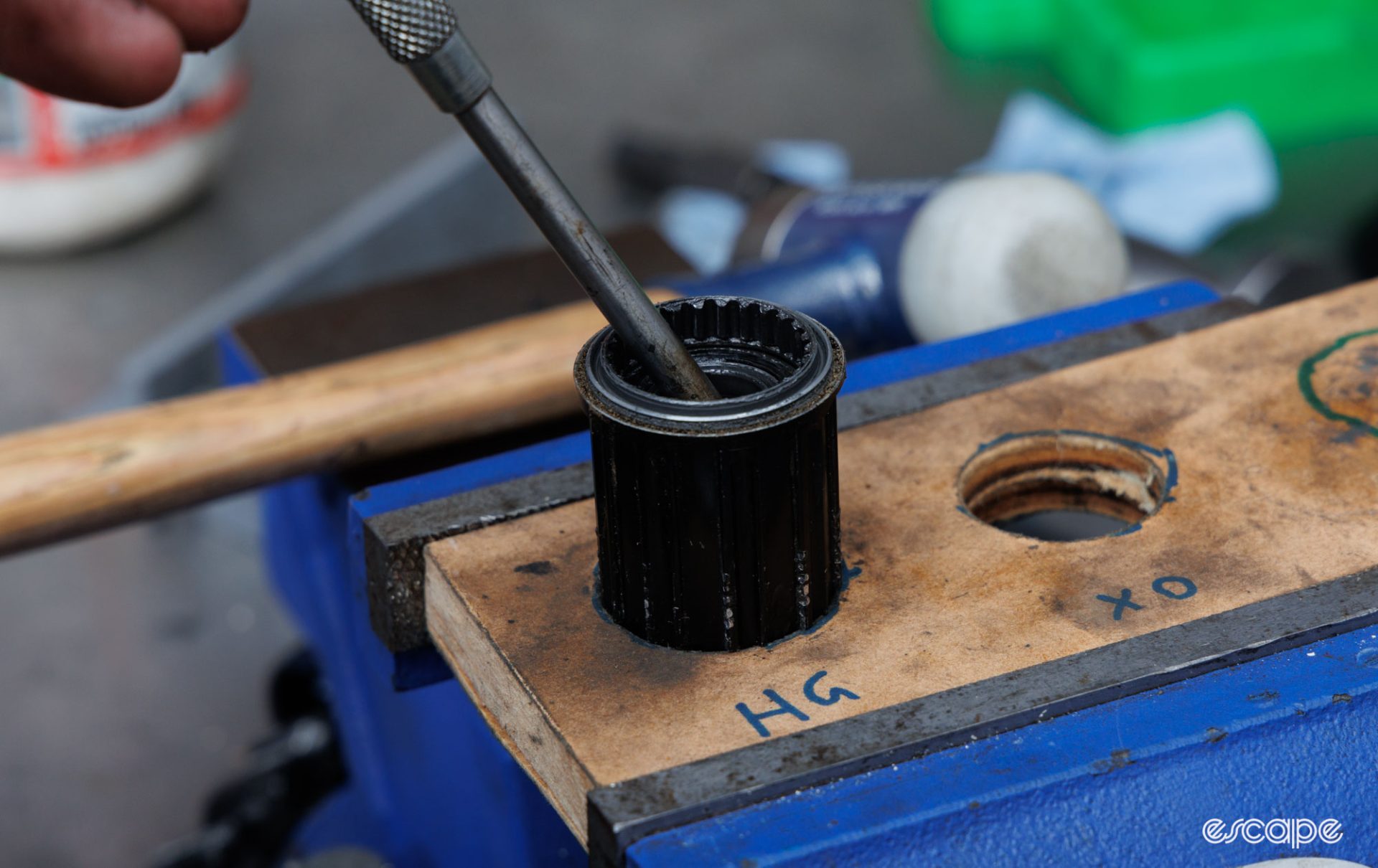
If you’re keen for a more visual explanation of many things covered here then I encourage you check out Alt-Alt’s website. This isn’t an ad, but their investment into impressively good technical drawings and instructional content on a rarely covered topic has earned them a shout-out.
Pro tips for self-justifying tool purchases
Wanted tools for Christmas and instead got socks? Here’s a quick pro tip for self-justifying those tools purchases:
You may not need it now, but (maybe) one day you will.
More to come
You can expect more Threaded throughout 2024. The next edition is likely to take a break from cartridge bearings and will rather take a tool and mechanic-focused look at the world of travelling race mechanics. Oh yes, Tour Down Under is just around the corner!
Did we do a good job with this story?

